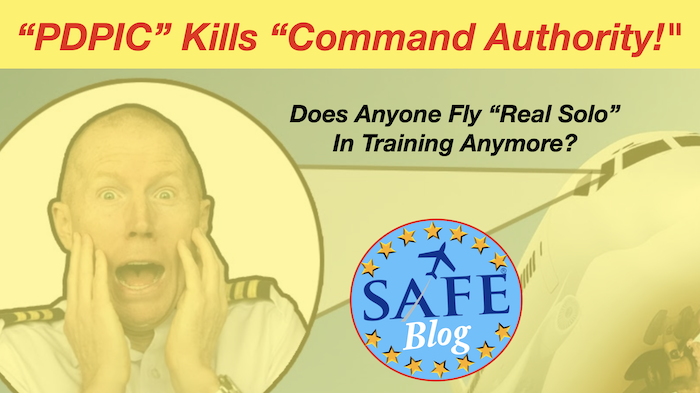
One of the silent killers of true pilot proficiency in modern flight training has been the FAA’s acquiescence to “supervised solo time:” 14 CFR 61.129(a)(4). This weird permission – and a separate category in modern logbooks – started when insurance companies increasingly refused to allow “real solo” during multi-engine commercial training. “Performing the Duties of Pilot in Command” (PDPIC) is flown with a CFI but “not dual” (or solo). The FAA now allows this time as “PIC” for all certifications beyond the private level. This shortcut quickly did away with *all* real solo flight opportunities in flight academies. Now most flight instructors are certificated with only 10 hours of “real PIC” (from their original private pilot experience). Ironically, most airlines hiring pilots regard PDPIC as “dual flight” anyway.
This “FAA loophole” quickly expanded to include all commercial “PIC” time, even in simple primary trainers. Previously, the required 300nm solo X-C and solo night (PIC), was a daunting (and character-building) experience. A similar diminishment of the challenge at the commercial level occurred when the “2-hour day/2-hour night” cross-country requirement (previously “VFR only”) was allowed to be flown as IFR training. The VFR original was an opportunity to build commercial-level X-C skills (a step up from the private pilot level). Now these flights are “double logged” to acquire the required 10 hours of IFR; faster/cheaper training.
Of course, removing retractable “complex time,” and redefining TAA aircraft as “complex,” was another a nail in the coffin of true commercial pilot proficiency. Retractable piston planes were just too old and scary after the landmark ERU Arrow crash. Most new commercial pilots only get retract time when they acquire their multi-rating.
Fortunately, most new pilots at the commercial/CFI level will only fly in a two-crew environment – the C-172 to Airbus conversion – so real solo “command authority” is not required. It is somewhat ironic that one of these “PDPIC-trained co-pilots” might actually be required to fly solo at some point in their careers. PDPIC might be a reason IOE is out of control in airline training and it is so hard for current airlines to upgrade their right-seaters to captains.
To log PDPIC time in an aircraft for which you do not hold a certificate for category, class, and type (if a type rating is required), you first receive the required training from an authorized instructor who then determines that you are ready to perform the duties of pilot in command.
When you perform the duties of pilot-in-command, your instructor is on board the aircraft, you are not the sole occupant, so do not log solo time. You log the time as pilot-in-command, not dual instruction. Your instructor also logs the time as PIC.
I was surprised at a recent FSDO gathering that many FAA inspectors had never heard of “PDPIC.” They were unaware of this diminishment of commercial-level pilot proficiency and were astonished that new CFIs only have 10 hours of solo time. (We were discussing all the recent CFI-supervised fender benders in the district; brave new world!)
If you are a newly certificated commercial pilot with limited real PIC (solo), building time alone in an airplane is an amazing opportunity for improvement (and fun). Real solo time builds confidence and control skills. This is a worthwhile investment in your safety. And mastering tail wheel or glider flight are both excellent pathways for skill improvement. PLease keep learning and growing; aviation is about pursuing excellence; and FAA minimums are increasingly minimal. Fly safely out there (and often)!
 Our SAFE CFI-PRO™ webinar series continues with the presentation of “Reflective Analysis” on May 26th at 8pm EDT. This is an amazing tool for building proficiency (and safety) at every level. Register here!
Our SAFE CFI-PRO™ webinar series continues with the presentation of “Reflective Analysis” on May 26th at 8pm EDT. This is an amazing tool for building proficiency (and safety) at every level. Register here!
SAFE CFI-PRO™ provides the “Missing Manual” of master CFI techniques (what the FAA did not teach you). This program allows flight instructors to accelerate their teaching performance from “good to great.” FAA Master WINGS credit is available for participation and the two YouTubes from previous webinars are available on the SAFE YouTube channel.
Discover more from reviewer4you.com
Subscribe to get the latest posts to your email.





